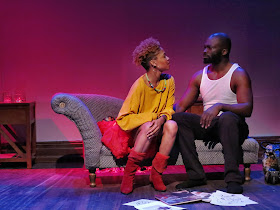 |
| Sara Juli in her show, Burnt-Out Wife, at Dixon Place (photo: Nick Pierce) |
Burnt-Out Wife
Sara Juli
Dixon Place
February 21-28
What a set! Designer Pamela Moulton's vision for Burnt-Out Wife, a solo performance by multi-talented Sara Juli, is lying in wait for the Dixon Place audience. And I say that advisedly, for this set is a monster, an eyesore. A cotton-candy-pink bathroom complete with polka dot toilet seat cover, a filmy pin-up girl robe with hot pink feather boa trim; and a wall splotched with wound-like flowers crafted, with childlike imperfection, out of who knows what. You gaze and wonder what Juli has in store for her unsuspecting visitors.
Burnt-Out Wife is everything that set suggests--and more. "I wanna get married...that's why I was born," sings Nellie McKay in the wry, melancholic song that ushers in this brilliant performance. Juli appears, giving the left-up toilet seat a certain look that immediately invokes the mate at fault and aiming another look at two baby dolls strewn about the floor. But if you think that tells you everything you'll need to know about Juli's project, think again.
Written by Juli, the performance draws clarity and vitality from her background in dance and stand-up comedy, and she shows ease and confidence in both genres. Marital burnout might not be first on your list of the funniest things in life, but Juli is really funny without straining and really fresh. She looks like a woman waking up to realize she's an Amazon and one with a future in performance art. She's physically strong--as you'll discover if she shakes your hand in a firm grip or strikes poses to represent the misalignment between her desires and her husband's--stronger than you might suspect from the weary look she gives the world most of the time. And she's smart as a whip, more than holding her own with the unseen spouse and her wackadoodle surroundings as she slyly, steadily lays waste to heteronormative conventions. In fact--through the magic touch of Moulton, costume designer Carol Farrell, sound designer Ryan McDonald and lighting designer David Ferri--she turns her hideous bathroom into a throne room worthy of pissed-as-hell royalty.
The surprises, joys and rewards of this show are many, and I will not spoil them for you as I hope you'll make your way to Dixon Place tonight for the final performance. But hurry! Last night's show was packed with happy people laughing their heads off.
Burnt-Out Wife concludes this evening with a show at 7pm. For information and tickets, click here.
Dixon Place
161A Chrystie Street, Manhattan
(map/directions)
******
DISCLAIMER: In addition to my work on InfiniteBody, I serve as Senior Curatorial Director of Gibney. The postings on this site are my own and do not necessarily reflect the views, strategies or opinions of Gibney.
******


